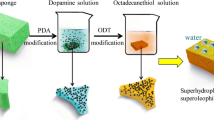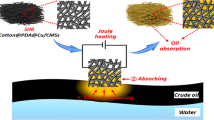Abstract
Fabrication of suerhydrophobic materials towards oil/water separation and oil absorption has been receiving great attention nowadays, due to the significant increase of industrial oily wastewater and frequent accident of oil spill. In most previous studies, the usage of expensive precursors restricted the wide applications of prepared superhydrophobic materials. In this work, superhydrophobic filter paper, fabric and polyester sponges were fabricated by dip-coating the mixed solution of polystyrene and xerogels, which were prepared with tetraethoxysilane and polymethylhydrosiloxane, based on previous work. The as-fabricated fabric can effectively separate oil and water mixtures and possesses excellent reusability; more significantly, the materials maintained its good hydrophobic and excellent oil/water separation capacity even after ten cycles. Interestingly enough, the stability was provided, as a result, the fabric still exhibited superhydrophobic after 100 abrasion times and showed high repellency towards many liquids with different pH values. Additionally, the coated polyester sponges can quickly absorb various oil and organic liquid, which will offer a practical application for the treatment of seawater or oily wastewater. By contrast, this experiment process is simple and avoided using costly fluoro-chemicals or complicated fabrication process.









Similar content being viewed by others
References
Al-Majed AA, Adebayo AR, Hossain ME (2012) A sustainable approach to controlling oil spills. J Environ Manage 113:213
Mullin JV, Champ MA (2003) Introduction/overview to in situ burning of oil spills. Spill Sci Technol Bull 8:323
Lin JY, Tian F, Shang YW, Wang FJ, Ding B, Yu JY (2012) Facile control of intra-fiber porosity and inter-fiber voids in electrospun fibers for selective adsorption. Nanoscale 4:5316
Korhonen JT, Kettunen M, Ras RHA, Ikkala O (2011) Hydrophobic nanocellulose aerogels as floating, sustainable, reusable, and recyclable oil absorbents. ACS Appl Mater Interfaces 3:1813
Tang XM, Si Y, Ge JL, Ding B, Liu LF, Zheng G, Luo WJ, Yu JY (2013) In situ polymerized superhydrophobic and superoleophilic nanofibrous membranes for gravity driven oil–water separation. Nanoscale 5:11657
Yip TL, Talley WK, Jin D (2011) The effectiveness of double hulls in reducing vessel-accident oil spillage. Mar Pollut Bull 62:2427
Yang Y, Wang H, Li JX, He BQ, Wang TH, Liao SJ (2012) Novel functionalized nano-TiO 2 loading electrocatalytic membrane for oily wastewater treatment. Environ Sci Technol 46:6815
Liu H, Cao CY, Wei FF, Huang PP, Sun YB, Jiang L, Song WG (2014) Flexible macroporous carbon nanofiber film with high oil adsorption capacity. J Mater Chem A 2:3557
Li SJ, Wei YQ, Huang JG (2010) Facile fabrication of superhydrophobic cellulose materials by a nanocoating approach. Chem Lett 39:20
Jin CF, Yan RS, Huang JG (2011) Cellulose substance with reversible photo-responsive wettability by surface modification. J Mater Chem 21:17519
Jin CF, Jiang YF, Niu T, Huang JG (2012) Cellulose-based material with amphiphobicity to inhibit bacterial adhesion by surface modification. J Mater Chem 22:12562
Xue CH, Ma JZ (2013) Long-lived superhydrophobic surfaces. J Mater Chem A 1:4146
Feng L, Li S, Li Y, Li H, Zhang L, Zhai J, Song Y, Liu B, Jiang L, Zhu D (2002) Superhydrophobic surfaces: from natural to artificial. Adv Mater 14:1857
Zhang ZX, Li YN, Ye M, Boonkerd KK, Xin ZX, Vollmer D, Kim JK, Deng X (2014) Fabrication of superhydrophobic surface by a laminating exfoliation method. J Mater Chem A 2:1268
Zhang X, Geng T, Guo YG, Zhang ZJ, Zhang PY (2013) Facile fabrication of stable superhydrophobic SiO2/polystyrene coating and separation of liquids with different surface tension. Chem Eng J 231:414
Wang CF, Lin SJ (2013) Robust superhydrophobic/superoleophilic sponge for effective continuous absorption and expulsion of oil pollutants from water. ACS Appl Mater Interfaces 5:8861
Wu L, Zhang JP, Li BC, Wang AQ (2014) Mechanical- and oil-durable superhydrophobic polyester materials for selective oil absorption and oil/water separation. J Colloid Interface Sci 413:112
Nagappan S, Park JJ, Park SS, Lee WK, Ha CS (2013) Bio-inspired, multi-purpose and instant superhydrophobic–superoleophilic lotus leaf powder hybrid micro–nanocomposites for selective oil spill capture. J Mater Chem A 1:6761
Wu L, Zhang JP, Li BC, Wang AQ (2014) Magnetically driven super durable superhydrophobic polyester materials for oil/water separation. Polym Chem 5:2382
Liang WX, Guo ZG (2013) Stable superhydrophobic and superoleophilic soft porous materials for oil/water separation. RSC Adv 3:16469
Xue CH, Ji PT, Zhang P, Li YR, Jia ST (2013) Fabrication of superhydrophobic and superoleophilic textiles for oil-water separation. Appl Surf Sci 284:464
Rao AV, Latthe SS, Mahadik SA, Kappenstein C (2011) Mechanically stable and corrosion resistant superhydrophobic sol–gel coatings on copper substrate. Appl Surf Sci 257:5772
Latthe SS, Imai H, Ganesan V, Kappenstein C, Rao AV (2010) Optically transparent superhydrophobic TEOS-derived silica films by surface silylation method. J Sol-Gel Sci Technol 53:208
Deng ZY, Wang W, Mao LH, Wang CF, Chen S (2014) Versatile superhydrophobic and photocatalytic films generated from TiO2–SiO2@PDMS and their applications on fabrics. J Mater Chem A 2:4178
Crick CR, Parkin IP (2011) Superhydrophobic silica films on glass formed by hydrolysis of an acidic aerosol of tetraethylorthosilicate. J Mater Chem 21:9362
Zheng ZR, Gu ZY, Huo RT, Ye YH (2009) Superhydrophobicity of polyvinylidene fluoride membrane fabricated by chemical vapor deposition from solution. Appl Surf Sci 255:7263
Wang FJ, Lei S, Xue MS, Ou JF, Li W (2014) In situ separation and collection of oil from water surface via a novel superoleophilic and superhydrophobic oil containment boom. Langmuir 30:1281
Zhang JL, Pu G, Severtson SJ (2010) Fabrication of zinc oxide/polydimethylsiloxane composite surfaces demonstrating oil-fouling-resistant superhydrophobicity. ACS Appl Mater Interfaces 2:2880
Tiwari MK, Bayer IS, Jursich GM, Schutzius TM, Megaridis CM (2010) Highly liquid-repellent, large-area, nanostructured poly(vinylidene fluoride)/poly(ethyl 2-cyanoacrylate) composite coatings: particle filler effects. ACS Appl Mater Interfaces 2:1114
Zhai SR, Zhai B, An QD (2011) Effect of preparation conditions on structural properties of PMHS–TEOS hybrid materials. J Sol-Gel Sci Technol 59:480
Zhai SR, Zhang L, Zhai B, An QD (2012) Facile sol–gel synthesis of thiol-functionalized materials from TEOS–MPTMS–PMHS system. J Sol-Gel Sci Technol 61:23
Zhai SR, Song Y, Zhai B, An QD, Ha CS (2012) One-pot synthesis of hybrid mesoporous xerogels starting with linear polymethylhydrosiloxane and bridged bis-(trimethoxysilyl)ethane. Microporous Mesoporous Mater 163:178
Zhai SR, Shao X, Zhou D, Zhai B, An QD (2012) Sol–gel synthesis of nanosilver embedded hybrid materials using combined organosilica precursors. J Sol-Gel Sci Technol 62:281
Zhu XT, Zhang ZZ, Men XH, Yang J, Wang K, Xu XH, Zhou XY, Xue QJ (2011) Robust superhydrophobic surfaces with mechanical durability and easy repairability. J Mater Chem 21:15793
Acknowledgments
Financial support from the Science and Technology Program of Dalian (2013A16GX117) and the Program for Liaoning Innovative Research Team in University (LT2013012) is highly appreciated.
Author information
Authors and Affiliations
Corresponding authors
Rights and permissions
About this article
Cite this article
Guo, P., Zhai, SR., Xiao, ZY. et al. Preparation of superhydrophobic materials for oil/water separation and oil absorption using PMHS–TEOS-derived xerogel and polystyrene. J Sol-Gel Sci Technol 72, 385–393 (2014). https://doi.org/10.1007/s10971-014-3446-x
Received:
Accepted:
Published:
Issue Date:
DOI: https://doi.org/10.1007/s10971-014-3446-x




